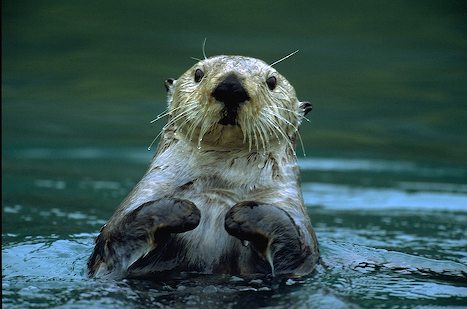Whiffen the sea otter passed away on May 10 during an MRI scan at the Vancouver Aquarium Marine Mammal Rescue Centre. Three months earlier he was found stranded on a beach, his hind flippers injured. According to the aquarium’s veterinarian, Whiffen was likely infected with Toxoplasma gondii, a parasite from cat feces that finds its way into the ocean (this is why you shouldn’t flush cat poop down the toilet).
New research shows that a different microbe was associated with disease in sea otters that died in an “unusual mortality event” in Southcentral Alaska between 2004 and 2008. Almost half the otters died from valvular endocarditis, or inflammation of tissue lining the heart valves. A team of scientists from the University of California, Davis, the U.S. Fish and Wildlife Service and Alaska Veterinary Pathology Services found Streptococcus infantarius bacteria in two-thirds of the inflamed heart valves. Similar bugs live comfortably in the guts of cows and sheep, but can also cause endocarditis in various animals, including humans.
In a paper published in the June 4 issue of Veterinary Microbiology, the researchers report that some of the sea otters were also infected with another type of bacteria: several species of Bartonella. Best known as the cause of cat scratch fever in humans, Bartonella henselae is transmitted to mammals by arthropods such as fleas (a scratch can spread the bacteria via flea feces). Recently Bartonella has been detected in the organs of dolphins and harbor seals, but this is the first time it’s been found in the hearts of marine mammals.
“That’s when we thought that northern sea otters may be co-infected by more than one pathogen, so it’s not just strep,” said veterinarian Sebastian Carrasco, the lead author of the study, who is now a graduate student at the Indiana University School of Medicine. “We initially thought that there was a ‘super’ bacterial infection in the heart that led to lesions in heart valves of northern sea otters.” But Bartonella was just as common in the heart valves of sea otters that died of other causes as it was in those with endocarditis.
It’s not yet clear whether Bartonella actually makes otters or other marine mammals sick. Unlike streptococci, Bartonella bacteria are very difficult to grow from post-mortem samples in the laboratory; instead of culturing the bugs, the scientists amplified Bartonella DNA directly from otter tissues. These sequences serve as preliminary evidence that Bartonella is present in sea otters, but can’t reveal the pathogen’s strategies for moving between hosts or causing disease.
Though Bartonella DNA has been found in lice living on harbor seals and in the tiny crustacean parasites of a dolphin, the arthropod vectors that carry Bartonella in the ocean also remain a mystery. Perhaps there isn’t even a vector in the ocean. “It could be that sea otters are sharing a vector with terrestrial animals, since they can haul out onshore,” Carrasco said. “Unfortunately we don’t have evidence of that.”
Bartonella wouldn’t be the first potential pathogen to make its way from land to sea. Terrestrial microbes and toxins have contributed to the deaths of hundreds of sea otters over the past two decades. This hampers the population recovery of these endangered animals, which were hunted nearly to extinction for the fur trade in the 18th and 19th centuries. Otters eat large amounts of mussels and clams, which filter-feed ocean water for plankton. The mollusks pick up pathogens, as well as toxins released by algae in polluted lakes (like Watsonville’s Pinto Lake), which enter the ocean in runoff water.
A 2012 study found that some mussels in California contained similar strains of Streptococcus infantarius to the ones in stranded otters, suggesting mussels could be a source of strep infection. Scientists know even less about infectious diseases that may impact the health and survival of Alaskan sea otters. This is partly because the animals are often stranded in remote areas. “This has been well characterized for California sea otters in Monterey, as well as in Morro Bay—they’re hotspots of disease and have been linked to pathogen pollution,” Carrasco said. “In Alaska, we are still learning about the pathogens that affect the northern sea otters.”
As researchers at the University of California, Santa Cruz have found, sea otters can have far-ranging effects on the balance of other species around them, eating urchins that would otherwise wipe out vital plants such as kelp and seagrass. “Sea otters serve a key role in maintaining healthy kelp forests along the California coast and also serve as bioindicators of marine ecosystem health,” Carrasco said. “Because sea otters spend their lives in near-shore waters, they serve as sentinel species for pathogens and pollutants entering the ocean from the terrestrial sources.”
